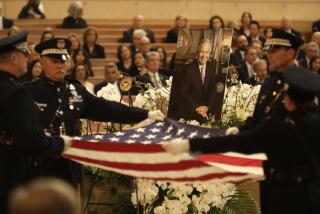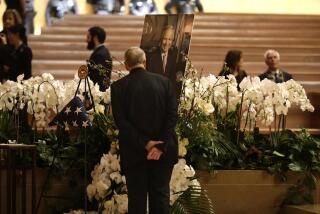Going Public : Riordan Raises His Profile After Poll Ratings Show Slippage
Making a recent guest appearance on a popular early morning radio show, the busy mayor of the nation’s second-largest city was exchanging banter with a woman caller pretending to seek his help with a vexing marital problem.
Complaining that it had been at least three months since she and her husband had had sex, the caller wanted her workaholic, racetrack-frequenting spouse to take her for a “wild weekend” at a hotel on their upcoming anniversary.
“This is a very, very interesting constituent problem,” chuckled Mayor Richard Riordan, playing along with the oddball antics of the hosts of KLOS-FM’s Mark and Brian Show. Getting her husband on the line, Riordan told the man he must honor his wife’s wish “or spend three days listening to the City Council.”
Every day, more than 600,000 L.A.-area drive-time listeners tune in to Mark and Brian. On this particular morning, they had Los Angeles’ top officeholder to entertain them. At one point, the 65-year-old mayor even took a studio tour on his roller-blades, wheels clicking into the microphone as he went. But he also squeezed in a promise to bring another NFL team to the area by the 1996 football season, and he got to plug his efforts to make the city safer and more prosperous.
Talk about going for a high profile.
Ever since a Los Angeles Times poll last month showed that Riordan’s once-strong popularity had dipped significantly, the mayor’s closest advisers have stepped up their efforts to improve his visibility among constituents. At the midpoint of his first four-year term, and already committed to running for a second, Riordan saw his job approval among residents slide 13 points in a year, from 59% to 46%. He did better among registered voters, and with those who have long been key factors in city elections, including Jews, other whites, Westsiders and the elderly.
Yet even those residents who said they liked the way Riordan was handling the job were vague about why. While 16% said he can get things done, 11% gave him credit for effort and for making no major mistakes, and just 7% saw him as a strong leader.
The mayor’s low profile is largely of his own making, his close advisers concede. While he spends a lot of time out in public on community bike rides, luncheon speaking engagements, Police Academy graduations and even some of the ceremonial events he once eschewed, they are not the types of things that get much news coverage.
He doesn’t like to do press conferences, and he seldom gives interviews beyond the brief statements he makes when reporters catch up with him at a public appearance. His usual response to reporters seeking his comment on news developments is to issue a short statement through his press office, a technique that precludes follow-up questions.
One close adviser, who asked not to be identified, said Riordan, a multimillionaire businessman and lawyer before winning his first election bid two years ago, does not yet understand the importance of high visibility for someone in public office.
“He’s still making the transition from private to public life,” the adviser said. “In the 20 minutes it takes to personally return phone calls from reporters, he could make three calls to CEOs of businesses he wants to keep from leaving the city.”
Others offer a less charitable interpretation.
“I think it’s pretty obvious it’s deliberate,” said Democratic political campaign consultant Parke Skelton. Avoiding scrutiny by minimizing or carefully orchestrating press contact was “the MO he used during the campaign, and I don’t think he’s comfortable as a public persona even now.”
Such reticence has its price, Skelton added. “He loses the capability to generate public support behind his programs. Visibility is a huge part of leadership, especially in a city with a weak-mayor system” of government that delegates much power to the City Council.
The lack of coverage is not all Riordan’s fault, said Tom Sullivan, who ran Mayor Tom Bradley’s crackerjack press operation during the first, more vigorous half of that Administration’s 20-year tenure. In those days, Sullivan and his staff, all of whom had news experience, cranked out a steady stream of news releases, many of which were run, almost unedited, by some of the smaller daily and weekly newspapers. They released details of Bradley’s upcoming public events well in advance, scheduled frequent news conferences and did plenty of advance work to ensure maximum coverage of Bradley’s “area days” in various parts of the city.
But Sullivan, a locally based political and media consultant, noted that times have changed and more and more politicians want to “hide out” from a press corps they see as increasingly hostile. In Los Angeles, there are fewer newspapers covering local government, and most local television stations, which used to assign reporters to regular beats at City Hall, now show up only when there is a controversy. The result is a more contentious, less informed press corps, playing to audiences that display little interest in local politics, Sullivan said.
Bradley, dogged by controversies in the closing years of his Administration, clamped down on media access, prompting some reporters to dub him “the stealth mayor.”
Arnold Steinberg, who was Riordan’s chief strategist during the 1993 campaign, said the mayor is not alone in avoiding press conferences or other “high risk” vehicles.
“There is a general trend at all levels of government toward fewer news conferences,” Steinberg said, noting that elected officials see them as increasingly likely to result in a negative story--or no coverage at all.
Hence a growing number of prominent politicians, including Gov. Pete Wilson and President Clinton, try to get their messages out by showing up at widely broadcast disaster scenes, giving one-on-one interviews with reporters they know or by speaking directly to voters through talk shows or “town hall” sessions in which constituents, not reporters, get to ask the questions.
Robin Kramer, a political veteran recently elevated to Riordan’s chief of staff during a midterm office shake-up, said several changes are under way to boost the mayor’s visibility. They are coming partly from an ongoing staff reorganization--changes in the press office and a new, politically savvy scheduler, for example--and partly from Riordan’s realization that he needs to be more accessible.
“The mayor is a better communicator” than when he first sought public office and “he’s less shy” about speaking with reporters, even those he dislikes, Kramer said. Riordan is also more aware of the importance of sounding his own horn, she added.
“He’s been so busy doing things, that he, and we, sometimes forget to talk about what he’s doing. The mayor doesn’t have much regard for folks who just talk, but he’s getting pretty sophisticated now about the need to get his message out and the power of the media,” Kramer said.
In recent weeks Riordan has been experimenting with ways to raise his profile. His press office has stepped up the flow of statements and news releases. Riordan got himself invited to participate in Police Chief Willie L. Williams’ latest monthly media briefing and talked, in a roomful of reporters and TV cameras, about ways to raise officers’ morale and stem attrition. His press office complained when he did not get mentioned in a news story about efforts to replace an adult movie house in the San Fernando Valley with a cultural arts theater.
He held well attended City Hall news conferences to announce efforts to find another professional football team to replace the departed Raiders, introduce his closely watched appointments to the Police Commission and, with community leaders and Councilman Mike Hernandez, discuss developments in the police shooting of a 14-year-old suspected gang member in Lincoln Heights.
The mayor seemed most at ease, however, during a carefully orchestrated kickoff of an anti-graffiti campaign last week at a Hollywood elementary school. Trailed by scores of excited children, he joined council members John Ferraro and Jackie Goldberg in painting out graffiti on the wall of a neighboring flower shop. He paid tribute to the volunteer Hollywood Beautification Team that was heading the project and posed gamely for pictures with Jiminy Cricket and Captain Beautiful, a new character portrayed by a Walt Disney Co. vice president. The captain’s purple-red-and-gold “Wipe Out Wagon,” a specially equipped van donated by his creators, is to be used to paint over graffiti in Hollywood and other communities, Riordan told the wide-eyed students.
“Hey, kids, you’ll be on TV if you come over here,” Riordan said at one point, gesturing at the half-dozen or so news cameras pointed his way. Then he urged the obliging students to join him in making “the stupidest face we can.”
The mayor hung around for an hour while aides nervously checked their watches and a woman down the street came out of her house to complain to a deputy about a city tree badly in need of trimming.
Good cause, good press, good chance to clown around with the kids. And no tough questions--unless you count the woman with the tree.
More to Read
Sign up for Essential California
The most important California stories and recommendations in your inbox every morning.
You may occasionally receive promotional content from the Los Angeles Times.











